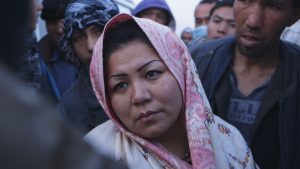(THIS ARTICLE IS MACHINE TRANSLATED by Google from Norwegian)
Laila Haidari, a chubby Afghan woman of the 30 years, wears her ballerina shoes and walks ahead under the notorious Pul-e Sukhta Bridge, where she moves in heavy stench between used syringes and swallowed bodies. Opium-addicted men, many older than her, tenderly call her "mother." In return, she refers to them as "my boys" and urges them to come to her makeshift rehabilitation center, called "Mother Camp."
Laila at the Bridge is an observational documentary that patiently follows the Afghan woman as she tries, on her own, to help the drug addicts in the center she runs without the support of the government or foreign aid.
An anesthetic
Rescuing the addicted seems like a Sisyphean task, for Haidari is facing setbacks, financial obstacles and opposition from the authorities. For a while, she financed her hostels with funds from her own restaurant, awaiting addicts as a labor force, but it soon became a futile project after a series of attacks drove customers away. "War, war, everything is due to war," Haidari says with empathy as drug addict Ikhtiar Gul tells his story. He was a former bodyguard to Afghan President Najibullah Ahmadzai, but is now a disgusted man who refuses to cut his beard because he does not want a scar from a bullet to appear. Yellow is one of the thousands who began using drugs after being attacked by insurgents in a marketplace or at work. The US-led invasion of the country in 2001 has not helped curb opium production and trade; in fact, the numbers have been rising since the operations were launched by Washington and their allies. The film points out that Afghanistan now accounts for 90 percent of the world's opium production; It has led to sharply falling prices in the domestic market and resulted in the highest level of drug addiction in the world.
The documentary does not try to explain how Western intervention has brought Afghanistan to the brink of being a drug addict. However, the film puts the spotlight on the sheer hypocrisy that characterizes the Afghan government's anti-drug work. "Unfortunately, everything in Afghanistan is symbolic. "Everything is a show," Haidari said during a 1TV Kabul debate on Afghanistan's "biggest challenge" – the cultivation, smuggling and sale of drugs. The hollowness is palpable when a delegation from the Ministry of Anti-Drugs demands a higher standard of the camp during a visit to Haidari's temporary accommodation. It is a demand Haidari does not hesitate to answer: "Do not give me the politics nonsense. […] Did you say that my camp does not maintain a good enough standard? To hell with their standards! Is under the bridge 'standard'? […] You can only say 'Get a better standard in your camp.' With what money? »
The ministry hardly knows what "standard" is, but it never leaves an opportunity to run a show boasting how effective it works. The cameras are always present when the authorities fire seized drugs in the "serious and strong fight against the drug addict". But when asked who the mafia is and why Afghanistan is still the world's largest producer of opium after many years of fighting, the ministry's Deputy Minister Mohammed Ibrahim Azhar can't find a better answer than saying that the mafia "is not a group of ordinary people".
No miracle factory
The longing for something resembling a life permeates the entire film. But life, for thousands of Afghans unfamiliar with drug addiction, is marked by a different kind of celebration. A group of waiting addicts gather around two birthday cakes with eight and two candles, respectively, to celebrate the birthday of Marzia, the daughter of Haidari's brother, who turns eight, and her father, Hakim, who celebrates two years of sobriety. Laila at the Bridge tells of the tough struggle of many Afghans who defy the endless war and the looming death are able to rise again, and perhaps even share laughter or a dance.

Yet, despite years of struggles and billions of dollars spent, Afghanistan could not be further away from overcoming its drug problem. The sight of abusers pushing for food under the bridge, or an addicted mother feeding her sobbing child with an opium mixture she has taken from a UNICEF bag, is a slap in the face. And that leaves us with little hope.
As the documentary nears the end, the camera hovers over the riverbed of the dried-out Kabul River, and we see Haidari descend back to the dark recesses under the bridge in his relentless efforts to save the "boys." The movie ends exactly where it began – at the bridge. "A person must cross the bridge himself," Haidari says, stating that "if they get a thousand relapses, if they want to be clean again," she will be there for them. But the question remains: Will the international community be there for them?


